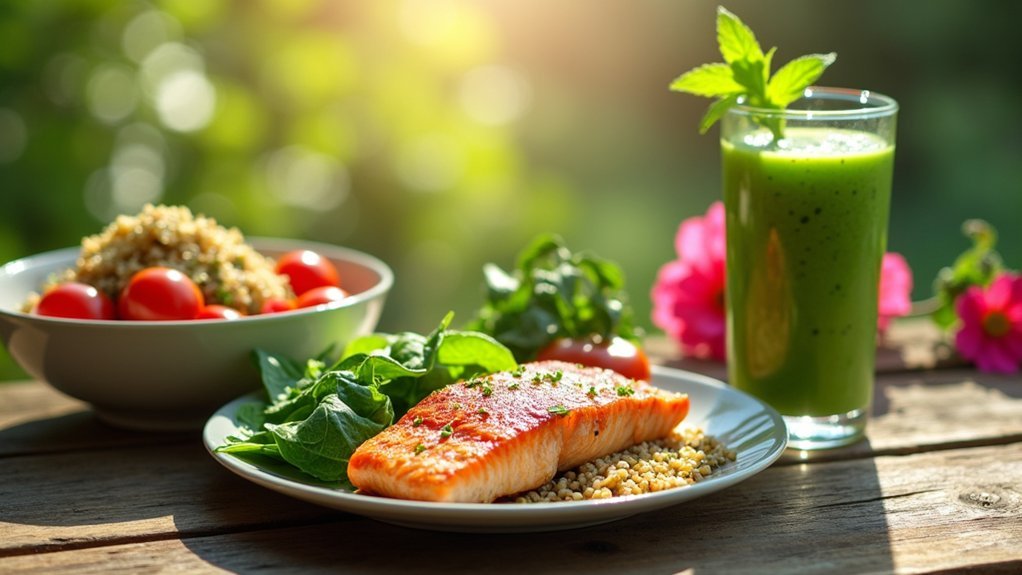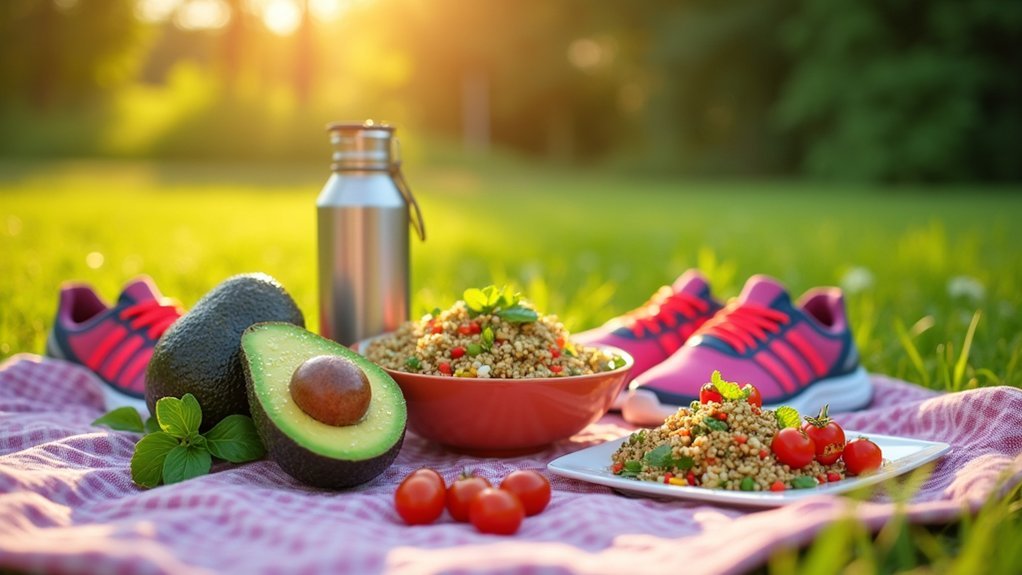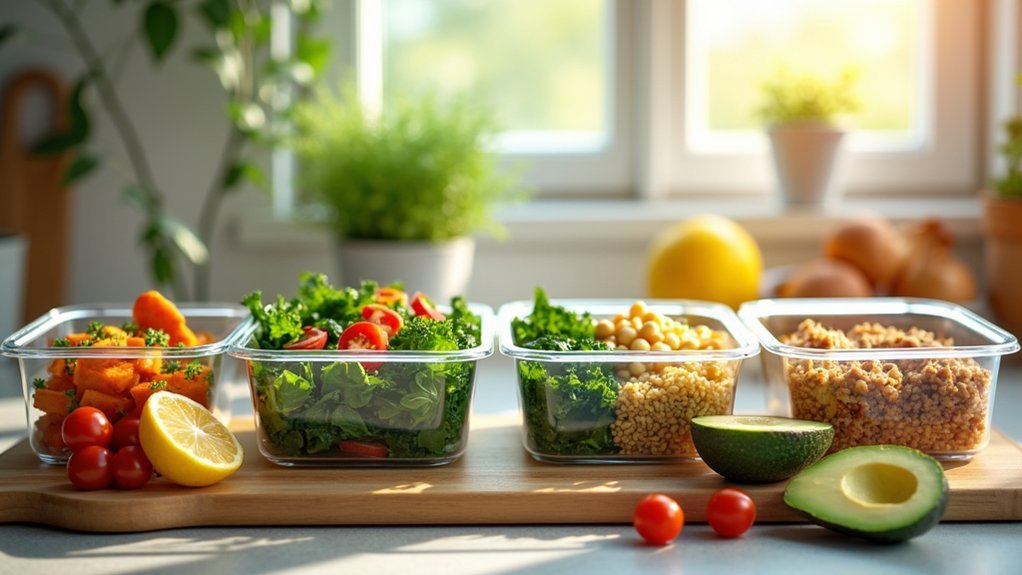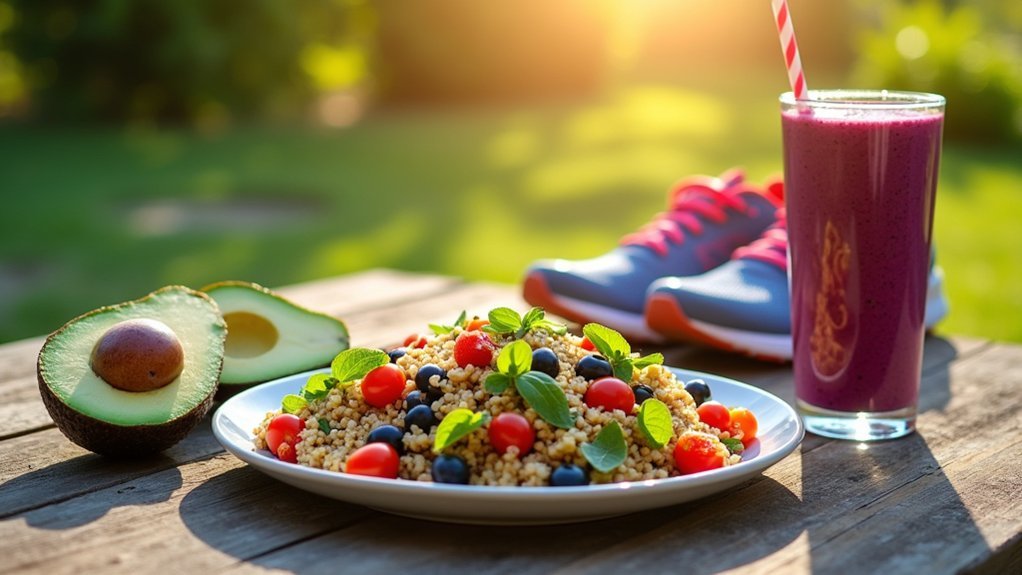Ideal post-spring workout recovery requires specialized nutrition within 30 minutes of exercise. Focus on protein-rich smoothies with anti-inflammatory ingredients like berries, turmeric, and ginger to combat joint stress from rebounding. Balance your meal with complex carbs and 20-40g of protein—try options like Chicken & Brown Rice Stir-Fry or Tropical Recovery smoothies. Don’t forget electrolyte replacement: sodium, potassium, and magnesium are critical after high-impact bouncing. Discover how timing these nutrients can cut recovery time by 25%.
Why Rebounding Demands Specialized Post-Workout Nutrition

While traditional workouts tax your body in predictable ways, rebounding creates unique physiological demands that require specialized nutritional strategies.
Your metabolic rate triples during trampolining, depleting glycogen stores faster than ground-based exercises.
The lymphatic circulation activation during bouncing accelerates toxin removal but demands proper electrolyte replacement.
Those G-force variations of 3-5x your body weight intensify joint and muscle stress, creating microscopic tears from eccentric contractions that need targeted protein repair.
You’ll also lose more water through respiration during aerial movements than during standard cardio. Having adequate hydration levels post-workout is essential for facilitating efficient recovery and optimal performance.
This combination of heightened metabolic demand, increased joint stress, and accelerated fluid loss means your post-rebound nutrition can’t follow conventional recovery guidelines if you want peak results and reduced recovery time.
Quick-Fix Recovery Smoothies for Trampoline Athletes
You’ll need protein-rich fruit blends packed with muscle-repairing nutrients like those found in banana-blueberry or tart cherry smoothies after intense trampoline sessions.
Adding hydration boosters such as coconut water or watermelon helps replenish electrolytes lost during your high-impact rebounds.
For maximum benefit, consume your recovery smoothie within 30 minutes post-bounce, taking advantage of the critical recovery window when your muscles are most receptive to nutrient absorption. Incorporating beet powder into your recovery smoothies can significantly enhance athletic performance by improving blood flow and oxygen utilization.
Protein-Rich Fruit Blends
After an intense trampoline session, your muscles crave rapid replenishment that combines quality protein with nutrient-dense fruits.
The right protein-fruit blend can slash recovery time while delivering essential nutrients when your body needs them most.
For ideal post-bounce recovery, blend these powerhouse combinations:
- Cherry-Chocolate Revival: Mix tart cherry juice with a scoop of chocolate protein powder and cocoa nibs for a delicious anti-inflammatory boost that relaxes tired muscles and fights oxidative stress. These tart cherries provide antioxidant benefits that may actually improve your athletic performance while supporting recovery.
- Tropical Recovery Champion: Combine pineapple chunks with Greek yogurt and a sprinkle of turmeric to harness the synergistic effect of bromelain and curcumin—your inflammation doesn’t stand a chance!
- Berry Muscle Mender: Blend blueberries with 3 tablespoons of hemp hearts, creating the perfect antioxidant-omega-3 duo that repairs muscle tissue while reducing soreness.
Hydration Boosting Ingredients
Proper hydration stands as the foundation for any effective post-trampoline recovery plan. After bouncing sessions, your body needs more than just water—it requires a strategic blend of electrolytes to restore balance.
Look for drinks containing essential minerals like magnesium, potassium, and sodium, which help regulate fluid balance and support muscle recovery. Products like Cira Nutrition Hydration offer these electrolytes in bioavailable forms without unnecessary sugars.
For a quick fix, try blending a hydration smoothie with frozen berries, yogurt, and electrolyte powder, or whip up a coconut water refresher with pineapple chunks.
The mango electrolyte boost—combining fresh mango, coconut water, and a pinch of salt—works wonders for replenishing what you’ve lost through sweat while supporting reduced recovery time. Drinking 6 to 8 ounces of these hydrating beverages every 15 to 20 minutes during your recovery period ensures optimal fluid restoration and helps prevent performance-hindering dehydration.
Post-Bounce Recovery Timing
Timing your recovery nutrition can make the difference between merely surviving your trampoline workout and truly thriving afterward. Your body enters a prime nutrient absorption window within 30 minutes post-workout, making this the perfect time to consume a protein-rich smoothie. This quick-fix strategy accelerates muscle repair and replenishes depleted glycogen stores. For optimal results, combine your recovery nutrition with a short rebounding session to clear lactic acid from your muscles and further enhance the recovery process.
- Beat the clock – Your muscles literally crave nutrients in the first 30 minutes after rebounding, when absorption rates peak and your body can utilize protein 66% more efficiently.
- Prevent breakdown – Every minute you delay refueling allows muscle-eating cortisol to dominate your recovery landscape.
- Maximize tomorrow – Early protein intake reduces DOMS by up to 25%, ensuring you’re ready for your next bounce session.
Complete Meals to Replenish Energy After High-Impact Bouncing
When your body has endured the intense demands of high-impact bouncing workouts, it requires carefully balanced meals to restore energy and repair muscle tissue effectively.
Aim for dishes that combine protein (20-40g) with complex carbohydrates (1-1.2g/kg of body weight).
Balance your recovery with precise protein-carb ratios for optimal muscle repair and energy restoration.
Try a protein-packed Chicken, Leek & Brown Rice Stir-Fry to deliver essential amino acids alongside slow-releasing energy.
For vegetarians, the Sesame Ginger Tofu + Crispy Brussels Bowl offers similar benefits while providing diverse micronutrients.
The Curried Spinach, Eggs & Chickpeas option delivers complete proteins with inflammation-fighting spices.
Prepare these meals in advance to guarantee you’re fueling properly within the vital post-workout window.
Remember to include plenty of fluids and electrolyte-rich foods like bananas to rehydrate effectively.
It’s crucial to consume your recovery meal within 90 minutes after finishing your workout for optimal nutrient absorption and glycogen replenishment.
Timing Your Nutrients: The 30-Minute Window After Rebounding

Is the 30-minute post-workout window truly essential for nutrient timing after rebounding exercises? The science suggests this urgency is often overstated.
While post-exercise nutrition matters, the “anabolic window” extends well beyond half an hour, especially if you’ve eaten before your rebounding session.
- Freedom from rigid timing – Your muscles remain receptive to protein for 24+ hours, allowing flexible meal planning that fits your schedule.
- Personalized approach – If you’re rebounding fasted, aim for protein within an hour; if fed, you’ve got 2-3 hours without compromising gains.
- Quality over immediacy – Focus on consuming 20-40g of quality protein with carbs rather than rushing an inferior option just to meet an arbitrary deadline.
The takeaway? Consistency trumps perfect timing for most rebounders. Research indicates that total daily protein intake between 1.6-2.2g/kg bodyweight is far more important than precise timing for optimal muscle adaptation.
Hydration Strategies Specific to Trampoline Workouts
Trampoline workouts demand specialized hydration approaches that go beyond simply drinking water.
You’ll need to balance electrolytes with sodium-potassium-magnesium blends during rebounds, prepare with 16-20 oz of fluid two hours before your session, and replenish within a critical post-workout window using water-rich fruits and 6-8% carbohydrate beverages.
Maintaining proper hydration supports your muscle recovery, prevents cramping in jumping muscles, and optimizes the lymphatic benefits unique to rebounding exercises. Since trampolining involves repetitive bouncing movements, consistency in hydration is essential for maintaining energy throughout your entire workout routine.
Electrolyte Balance During Rebounds
Maintaining proper electrolyte balance becomes especially vital during trampoline workouts, as the continuous bouncing motion intensifies sweat production and accelerates electrolyte depletion.
Your body loses sodium most rapidly, with potassium, magnesium, and calcium following closely behind. These electrolytes are essential for muscle function and recovery after intense rebounding sessions. The low-impact nature of trampoline exercises allows for longer workout durations, potentially increasing your overall electrolyte needs compared to high-impact activities.
For ideal recovery, you’ll need:
- Higher sodium intake than most standard electrolyte drinks provide – look for formulations specifically designed for intense exercise
- Strategic hydration timing – drink electrolyte-rich beverages before, during, and after your trampoline workout
- Balanced replenishment ratios – prioritize products containing all five primary electrolytes to support muscle function and reduce cramping
Don’t underestimate the importance of proper electrolyte balance – it’s your key to faster recovery and improved performance.
Pre-Jump Fluid Loading
While many exercisers focus on post-workout hydration, proper fluid loading before your trampoline session creates the foundation for peak performance and lymphatic flow.
Your lymphatic system requires adequate fluids to function effectively during high-impact rebounding exercises. Aim to drink 16-20 ounces of water two hours before jumping, followed by 8 ounces 15 minutes pre-workout. Rebounding workouts are especially beneficial for cardiovascular health while providing gentle impact on your joints compared to traditional exercises.
Add a pinch of sea salt to enhance absorption. Coconut water serves as an excellent pre-jump option, providing natural electrolytes that prime your system for the increased lymphatic pumping that occurs during bouncing.
Avoid sugary sports drinks which can cause energy crashes mid-workout. Instead, opt for room-temperature fluids that your body absorbs more efficiently than cold liquids, maximizing your lymphatic activation during those powerful spring movements.
Post-Trampoline Hydration Windows
After completing your bounce session, the timing of your rehydration matters as much as what you drink. Your body needs to replace fluids quickly, especially within the first 30 minutes after rebounding. Aim to consume about 150% of what you’ve lost through sweat—approximately 24 ounces for every pound shed during your trampoline workout. Mini trampolines are excellent for low-impact cardiovascular exercise while still providing significant calorie burn that necessitates proper hydration.
- First 30 minutes: Grab a room-temperature electrolyte drink with 300-600mg sodium to jumpstart recovery when your body’s absorption rate peaks.
- 30-60 minute window: Incorporate cucumber-infused water with a pinch of salt to continue steady electrolyte replenishment.
- 2-hour mark: Check your urine color—it should be pale yellow, signaling you’ve successfully rehydrated after your bouncing session.
Anti-Inflammatory Foods to Combat Joint Stress From Rebounding
Spring workouts that include rebounding exercises can place significant stress on your joints, making post-workout nutrition essential for recovery. Focus on incorporating anti-inflammatory foods that naturally reduce joint pain and inflammation from trampoline activities. A hunter-gatherer style diet approach can significantly reduce inflammation markers while supporting recovery from high-impact exercises.
| Food Type | Best Choices | Benefits | How to Consume |
|---|---|---|---|
| Proteins | Fatty fish (salmon, mackerel) | Omega-3 fatty acids reduce inflammation | Baked or grilled with herbs |
| Spices | Turmeric and ginger | Curcumin and gingerol fight inflammation | Add to smoothies or teas |
| Fruits | Berries and watermelon | Antioxidants and L-citrulline aid recovery | Fresh or in post-workout smoothies |
| Extras | Flaxseeds and walnuts | Plant-based omega-3s support joint health | Sprinkle on yogurt or oatmeal |
For maximum benefits, combine these foods into post-rebounding meals within 30 minutes of your workout.
Meal Prep Ideas for Week-Long Rebounding Recovery Success

Effective meal preparation becomes the foundation of your rebounding recovery strategy, turning good nutritional intentions into practical daily habits. Start by batch-cooking versatile protein sources like grilled chicken breast and hard-boiled eggs that you’ll use throughout the week in various dishes.
- Sunday Power Prep – Dedicate 90 minutes to roasting sweet potatoes, marinating chickpeas, and preparing slow-cooker turkey meatballs to guarantee you’re never more than minutes away from ideal nutrition.
- Container Strategy – Pre-portion your 1:2 protein-to-carb combinations in grab-and-go containers, eliminating decision fatigue when you’re fatigued from workouts. This approach is crucial for proper nutrient timing which plays a significant role in muscle recovery and growth.
- Component System – Rather than complete meals, prepare individual elements (proteins, complex carbs, healthy fats) that can be mixed and matched according to your daily recovery needs.
Frequently Asked Questions
How Do Recovery Needs Differ for Morning Versus Evening Workouts?
Morning workouts benefit from higher growth hormone levels, while evening workouts leverage peak neuromuscular performance. You’ll need to adjust meal timing and composition based on your body’s different hormonal and metabolic states during these times.
Can Intermittent Fasting Affect Post-Workout Recovery Efficiency?
Yes, intermittent fasting can impact your recovery efficiency. You’ll face delayed nutrient timing, though you can offset this by scheduling workouts near feeding windows and prioritizing protein intake when breaking your fast.
Are Plant-Based Proteins Equally Effective for Muscle Recovery?
Plant-based proteins can be equally effective for muscle recovery if you’re consuming sufficient quantities and ensuring adequate leucine content. You’ll need slightly higher doses compared to animal proteins to achieve similar muscle-building benefits.
How Should Recovery Meals Change Based on Seasonal Weather?
During warmer seasons, you’ll need to adjust your recovery meals to include more hydrating foods, electrolytes, and easily digestible nutrients. Opt for seasonal produce and increase fluid intake to combat higher sweat rates.
What Recovery Meals Work Best for Seniors After Low-Impact Exercise?
After low-impact exercise, you’ll recover best with protein-rich cottage cheese or salmon, paired with easy-digest carbs like sweet potatoes. Don’t forget anti-inflammatory foods like berries and plenty of hydrating fluids like herbal tea.
In Summary
You’ve got all the tools to fuel your body properly after those spring-loaded workouts. Remember, your post-rebounding nutrition isn’t just about eating—it’s strategic recovery that builds stronger muscles and prevents injury. Don’t skip that 30-minute refueling window, prioritize hydration, and embrace anti-inflammatory foods. With these tailored nutrition approaches, you’ll bounce back faster and perform better in your next trampoline session.





Leave a Reply